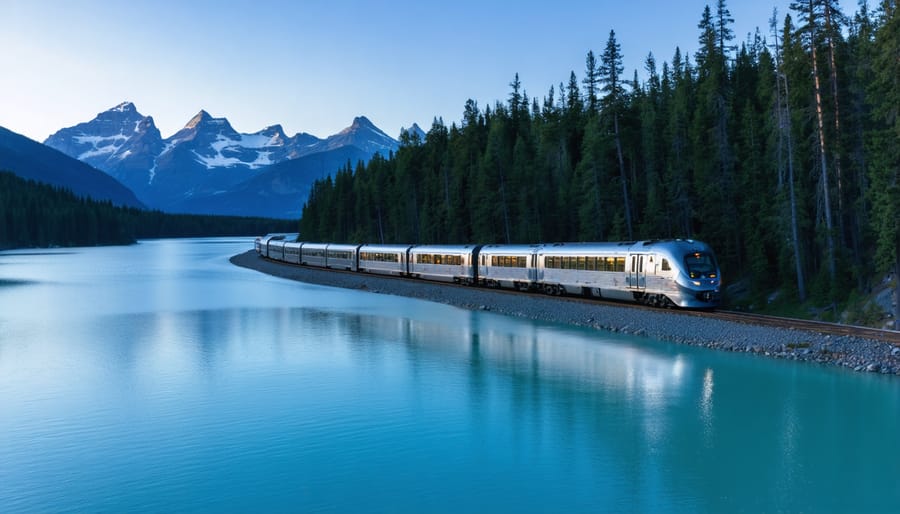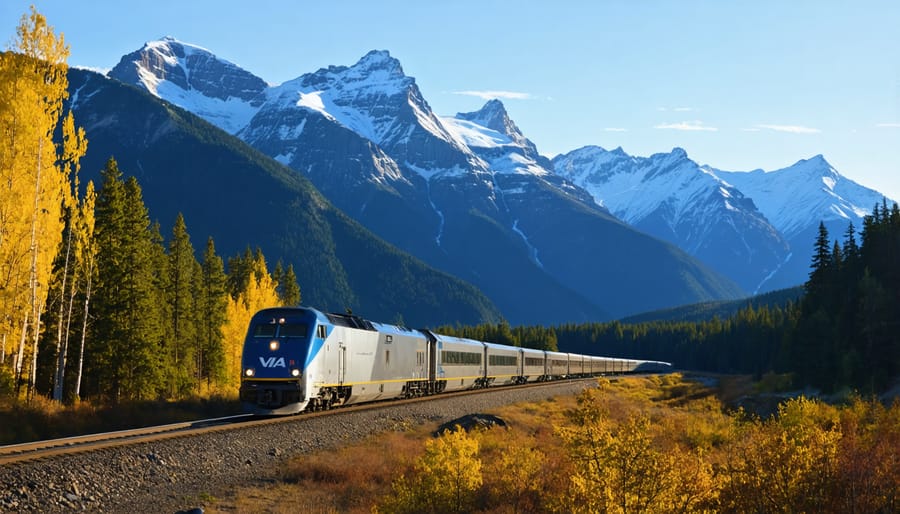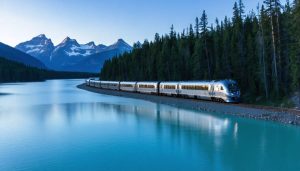
Canada’s transcontinental railway isn’t about breaking speed records—it’s about redefining what makes a train journey worthwhile. If you’re searching for the fastest train across Canada expecting bullet-train velocities, here’s the reality: VIA Rail’s **Canadian** travels from Toronto to Vancouver in approximately 4 days, averaging just 50-60 km/h including stops. Compare this to Japan’s Shinkansen at 320 km/h, and you’ll quickly realize Canadian rail prioritizes experience over efficiency.
But here’s what those speed statistics don’t tell you: this journey traverses 4,466 kilometers through the Canadian Rockies’ towering peaks, the vast golden prairies, and the remote wilderness of Northern Ontario—landscapes so stunning that passengers actually hope the train slows down. The **Canadian** isn’t transportation; it’s a moving observation deck with sleeping quarters.
For travelers genuinely needing speed, flying remains Canada’s only practical transcontinental option. However, dismissing train travel based solely on velocity means missing the point entirely. The glacial pace allows you to witness sunrise over Lake Superior, spot wildlife in Jasper National Park, and experience the rhythmic meditation of rail travel that our hurried world rarely permits.
This guide explores Canada’s transcontinental rail options, realistic travel times, route highlights, and why “fastest” might be the wrong question altogether when discovering this vast, beautiful country by train.
The Current Speed Reality: VIA Rail’s Transcontinental Service
Let’s address the elephant in the passenger car: VIA Rail’s transcontinental service, aptly named “The Canadian,” is not fast by modern standards—and that’s perfectly okay. This legendary journey connecting Toronto to Vancouver takes approximately four days to complete, covering 4,466 kilometers at an average speed of roughly 50-60 km/h. To put that in perspective, you could fly the same distance in about four hours.
Why so leisurely? The Canadian operates primarily on freight rail lines owned by private companies, meaning passenger trains frequently yield to cargo traffic. This reality, combined with mountainous terrain through the Rockies and numerous small-town stops, creates a schedule that prioritizes reliability over speed. The train typically departs Toronto three times weekly (more frequently in summer), winding through Northern Ontario’s forests, across the prairies, and through the dramatic mountain passes of British Columbia.
Despite its modest pace, The Canadian remains the only direct transcontinental passenger rail option in the country. There’s simply no faster train alternative—what you gain in time, you sacrifice in experience. The journey operates year-round, offering comfortable sleeper accommodations, a panoramic dome car for scenery viewing, and dining service that transforms travel time into an adventure rather than an inconvenience.
It’s worth noting that while speed-focused travelers might find the four-day commitment challenging, this isn’t a commuter service—it’s a mobile hotel showcasing Canada’s vastness. The “slowness” becomes part of the appeal, allowing passengers to witness landscape transitions that happen too quickly from airplane windows: watching boreal forests gradually give way to golden wheat fields, then witnessing prairie flatlands rise into snow-capped peaks. The Canadian isn’t designed to get you there quickly; it’s designed to make “getting there” unforgettable.

Faster Alternatives: Strategic Route Planning
The Corridor: Canada’s Speediest Rail Network
Canada’s busiest and fastest rail corridor stretches 1,150 kilometres between Quebec City and Windsor, threading through the country’s most densely populated region. This is where VIA Rail truly picks up the pace, offering the speediest regularly scheduled passenger service in the nation.
The crown jewel of this route is the Toronto-Montreal corridor, where sleek locomotives reach maximum speeds of 160 km/h (100 mph) on select track segments near Cobourg and Gananoque. While these bursts of velocity might not rival European or Asian bullet trains, they represent Canada’s fastest operational passenger rail speeds and create surprisingly efficient travel times between major urban centres.
VIA Rail’s flagship service here operates under the Corridor banner, connecting five provinces’ worth of business travellers, students, and tourists daily. The journey between Toronto and Montreal takes approximately 4.5 to 5 hours, while Toronto to Ottawa clocks in around 4 hours. Windsor to Toronto stretches to roughly 4 hours, and Quebec City to Montreal covers its distance in about 3 hours.
The trains themselves feature modern amenities that make even these shorter journeys comfortable: spacious seating, power outlets, complimentary Wi-Fi, and bistro cars serving locally-sourced snacks. Business class passengers enjoy elevated comfort with wider leather seats and meal service included.
What makes this corridor particularly special isn’t just the speed—it’s the accessibility. With multiple daily departures connecting Toronto, Ottawa, Montreal, and Quebec City, you can seamlessly weave rail travel into your itinerary. The frequent service means missing a train rarely derails your plans, and the stations nestle conveniently in downtown cores, eliminating lengthy airport commutes and security delays that often negate flying’s time advantage.
Regional Express Routes Worth Considering
While no single train crosses Canada at high speed, savvy travelers can optimize their transcontinental journey by strategically choosing regional services that maximize efficiency on specific segments.
**VIA Rail’s Ocean Service** connects Montreal and Halifax, and while it’s not primarily marketed for speed, selecting the direct routing rather than the scenic Maritime tour can trim hours from your eastern Canada travel. The streamlined schedule covers this corridor in approximately 21 hours, making it a practical option for those prioritizing arrival time over sightseeing stops.
**The Rocky Mountaineer** operates exclusively during daylight hours, which might seem counterintuitive for speed-focused travelers. However, this innovative approach eliminates the overnight layovers that plague traditional services. Their efficient routing between Vancouver and the Canadian Rockies means you’re consistently moving during operating hours, with luxurious overnight hotel stays replacing stationary sleeper cars. For the Vancouver-to-Banff segment specifically, this daylight model can actually save time compared to traditional overnight services.
**The Corridor Service** between Quebec City, Montreal, Ottawa, and Toronto represents Canada’s fastest regularly scheduled trains, with some routes reaching speeds up to 160 km/h. For travelers building a transcontinental itinerary, maximizing time on these Corridor trains—which offer frequent departures and relatively brisk travel times—can significantly accelerate your eastern Canadian leg.
**Regional connector services** linking smaller communities to major rail hubs occasionally offer unexpected time savings. The key is researching seasonal schedules and direct routing options that bypass unnecessary stops. While these aren’t glamorous express trains, strategic route planning using multiple regional services can genuinely shave hours off your cross-country adventure without sacrificing the authentic Canadian rail experience.
What Slows Canadian Trains Down
If you’ve traveled on Europe’s TGV or Japan’s Shinkansen, you might wonder why Canadian trains don’t zip across the country at similar speeds. The answer lies in a fascinating combination of geography, infrastructure, and economics that shape the Canadian rail experience into something entirely different—but no less remarkable.
**The Freight Factor**
Unlike dedicated passenger rail networks in Europe and Asia, Canadian trains share tracks with massive freight operations. VIA Rail, Canada’s national passenger service, doesn’t own most of the tracks it runs on—freight companies like Canadian National and Canadian Pacific do. When a two-kilometer-long freight train carrying grain or containers needs to pass, passenger trains wait. It’s simple track politics: freight pays the bills, so it gets priority. This sharing arrangement means passenger trains frequently travel at speeds well below what the tracks could technically support.
**Geography as Both Blessing and Barrier**
Canada’s landscape tells a story of extremes that engineers and train operators navigate daily. The Rocky Mountains present steep grades and hairpin curves where trains must slow to safely negotiate terrain that’s breathtaking for passengers but challenging for operations. Through the Prairies, despite seemingly endless flatness, track conditions vary with extreme temperature swings—rails that buckle in summer heat or contract in minus-forty winters require conservative speed limits.
The sheer vastness between major population centers makes high-speed rail economically complex. While France can connect multiple cities within 500 kilometers, Canadian trains traverse over 4,400 kilometers between Vancouver and Toronto through regions where communities are separated by hundreds of kilometers of wilderness.
**Population Reality**
Canada’s population density—roughly four people per square kilometer compared to Japan’s 340—means fewer passengers to justify the enormous infrastructure investment high-speed rail demands. Building dedicated tracks through the Canadian Shield’s ancient rock or maintaining them through harsh winters would cost billions, serving relatively small populations between major hubs.
These realities don’t diminish Canadian train travel; they simply reframe it. Instead of racing past scenery in a blur, you’re invited to witness the country’s transformation across days, not hours. The journey becomes the destination, offering a perspective no high-speed train could provide.
When ‘Fast’ Isn’t What You Really Want
The Scenic Trade-Off
Here’s the truth that transforms “slow” into spectacular: Canada’s trains move at precisely the right speed to drink in landscapes that would become mere streaks from a bullet train window. While high-speed rail might whisk you across the country in record time, you’d miss the golden hour light painting the prairie wheat fields amber, or the moment a black bear ambles along the tracks in the Rockies.
The stretch between Kamloops and Jasper stands as train travel’s masterpiece—where spiral tunnels wind through mountain passes and turquoise glacial lakes appear like jewels between peaks. At conventional speeds, you’ll actually spot bighorn sheep on cliffsides and watch eagles soar over the Fraser River canyon. Through the boreal forests of Northern Ontario, sunrise filters through endless stands of spruce and pine, while moose graze in marshlands—scenes that demand contemplation, not speed.
The prairies reveal their subtle magic at train pace too. What seems monotonous at first transforms into an ever-shifting canvas of canola fields, grain elevators standing sentinel on the horizon, and sunsets that stretch for what feels like hours across an impossibly wide sky. Even the remote northern shores of Lake Superior, with their ancient granite cliffs plunging into cobalt waters, deserve more than a fleeting glance.
This isn’t compromise—it’s the entire point. Canada’s vastness isn’t something to conquer quickly; it’s a story told one mesmerizing frame at a time.

Onboard Comfort Over Speed
While Canada’s trains may not break speed records, they’ve perfected something arguably more valuable: the art of comfortable transcontinental travel. VIA Rail’s *The Canadian* transforms the journey into a destination itself, where velocity takes a backseat to experience.
The spacious seating arrangements feel worlds apart from cramped airline cabins. In Economy class, you’ll find generous legroom and reclining seats with panoramic windows that frame the ever-changing Canadian landscape. Upgrade to Sleeper Plus, and private cabins become your mobile sanctuary, complete with comfortable beds, personal attendants, and access to exclusive lounges.
For those seeking ultimate luxury, the Prestige Class accommodations offer hotel-quality amenities on rails—think spacious cabins with full bathrooms and dedicated concierge service.
The dining car serves as the train’s social heart, where freshly prepared meals feature regional Canadian ingredients. Share stories with fellow travelers over Alberta beef or Pacific salmon while the Rockies roll past your window.
The Park Car observation dome deserves special mention—this glass-enclosed sanctuary at the train’s rear offers 360-degree views. Here, passengers gather for sunrise over the prairies or sunset behind mountain peaks, creating memories that no express service could match.
These thoughtful sleeper accommodations and amenities remind us that sometimes, the slower path offers richer rewards.

Insider Tips for Maximizing Your Time
Maximizing your transcontinental rail journey requires strategic planning that balances efficiency with experience. The savvy traveler knows that “fastest” doesn’t always mean rushing through—it means making every moment count.
**Book Early and Be Flexible**
VIA Rail releases schedules up to 11 months in advance, and booking early gives you first pick of departure dates. Mid-week travel typically offers more availability and sometimes better connections. Consider traveling eastbound rather than westbound—you’ll arrive at Toronto Union Station during daylight hours, making onward connections smoother.
**Strategic Segment Selection**
Mix daytime and overnight segments to experience Canada’s landscapes while covering ground efficiently during sleeping hours. The stretch through the Canadian Rockies absolutely deserves daylight viewing—book morning departures from Jasper to catch the sunrise over glacial peaks. Meanwhile, the prairie crossing between Winnipeg and Edmonton works beautifully as an overnight segment, letting you wake refreshed to mountain vistas.
**Transform Layovers into Mini-Adventures**
Extended layovers aren’t delays—they’re opportunities. A six-hour stop in Winnipeg? Perfect for visiting The Forks or the Canadian Museum for Human Rights, both within 20 minutes of the station. Edmonton layovers allow time to explore the river valley parks. Store luggage at station facilities and treat yourself to genuine local experiences rather than airport-style waiting.
**Seasonal Timing Matters**
Summer offers the longest daylight hours for scenery viewing, but shoulder seasons (May and September) provide clearer skies and fewer crowds. Winter travel can mean occasional delays due to weather, but you’ll witness the Rockies draped in snow—an unforgettable trade-off. Spring brings wildlife sightings as animals emerge near the tracks.
**Pack Smart for Efficiency**
Bring a day bag with essentials separate from checked luggage. During longer stops, you won’t waste precious exploration time retrieving items from storage. Download offline maps and research layover cities beforehand—knowing exactly where you’re headed saves valuable minutes.
**Connect with Crew Members**
Onboard staff possess insider knowledge about upcoming views, wildlife spotting opportunities, and which side of the train offers better vistas for each segment. Their recommendations often reveal hidden gems that guidebooks miss, enriching your journey beyond the destination.
So, what truly makes a train journey across Canada “fast”? Perhaps we’ve been asking the wrong question all along. The fastest way to cross Canada isn’t measured in kilometers per hour—it’s measured in how deeply you connect with the country’s staggering beauty and diversity. When you step aboard a transcontinental train, you’re not racing against time; you’re embracing it.
Think of it this way: a cross-country flight deposits you on the opposite coast in hours, but what have you really seen? The train transforms travel time into meaningful experience. Those extra days become opportunities to watch the Rocky Mountains paint themselves across your window, to witness prairie sunsets that seem to last forever, and to wake up surrounded by the Canadian Shield’s ancient granite and pristine lakes. This is efficiency redefined—not as speed, but as richness per mile traveled.
The key is shifting your mindset before you even board. Don’t think of train travel as slower; think of it as fuller. Come prepared with curiosity rather than impatience. Bring a journal, charge your camera, and leave your hurried expectations at the station.
Ready to experience Canada the way it deserves to be seen? Start planning your transcontinental adventure today. Choose the pace that lets you truly arrive—not just at your destination, but at a deeper appreciation of this vast, magnificent country stretching between three oceans.






